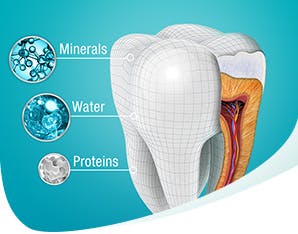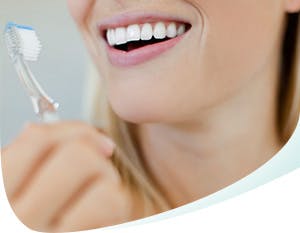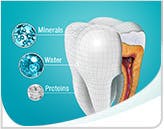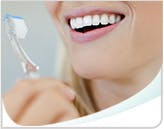What is Fluoride: How Fluoride Helps Your Teeth
Fluoride is a naturally occurring mineral that helps to prevent tooth decay by strengthening the enamel of your teeth.1 Learn more about this helpful mineral and how it’s an important part of your oral health care routine.
Key Takeaways
- Fluoride works by strengthening enamel and helping to reverse early decay.
It helps prevent cavities by combating acid attacks and restoring minerals to your teeth. This process is especially critical during early childhood and remains beneficial throughout adulthood.
- Fluoride is safe and widely recommended by dental authorities.
Leading health organizations such as the ADA and CDC endorse fluoride for its proven track record in reducing cavities and promoting long-term oral health.
- There are many sources of fluoride available in daily life.
From community fluoridated tap water and toothpaste to mouthwash and dental treatments, fluoride is easy to incorporate into your routine for better tooth protection.
Where Does Fluoride Come From?
Fluoride is a form of the element fluorine, and is often found in soil, water, plants and foods. For some people, fluoride intake comes from community fluoridated drinking water and oral health products that contain fluoride.2
How Does Fluoride Help Teeth?
Fluoride is often known as “nature’s cavity fighter.”1 It works to help teeth in a few different ways:
- It may reduce the amount of acid that cavity-causing bacteria produce.4
- It replaces the minerals lost from your tooth’s enamel due to acid breakdown.4
- It helps to strengthen tooth enamel and make it more resistant to cavities during a process called remineralization.1
What is Remineralization?
Remineralization is a process of depositing minerals into the surface of a tooth’s enamel.3 After you eat, the bacteria that live in your mouth consume sugars left on your teeth and release acids that attack the enamel of your teeth, causing it to become weaker over time.1
How Do You Get Fluoride?
- Dental products
Most toothpaste sold in the United States contains fluoride in the form of sodium fluoride, stannous fluoride or sodium monofluorophosphate.2 Fluoride toothpaste also increases the amount of fluoride in saliva, which helps rebuild the outer enamel layer.4 Other dental products that provide fluoride include mouthwashes for home use and topical fluoride preparations applied in dental offices.2
- Community Fluoridated water
The US Public Health Service has recommended that fluoride be added to tap water to reduce the severity of cavities since the 1960’s.2
- Food
Trace amounts of fluoride are naturally present in most foods, and in many cases, fluoride is added to foods during preparation with community fluoridated drinking water.2
Is Fluoride Safe?
Yes. According to leading health authorities like the American Dental Association (ADA), the World Health Organization, the American Medical Association and the Centers for Disease Control and Prevention (CDC), fluoride is safe and effective when used as recommended.1
Scientific evidence from studies conducted over the last 70 years has shown that community fluoridated water is safe and effective.1 What’s more, studies have shown that fluoride in water is particularly beneficial to children, as it helps to fight childhood cavities.1 One study indicated that children who drank community fluoridated water had 35% fewer decayed, missing, and filled primary (baby) teeth, and 26% fewer decayed, missing, and filled permanent (adult) teeth than children receiving unfluoridated water.2
How Does Fluoride Help Children?
Fluoride helps children by helping to strengthen the enamel on their baby teeth, even before they first break through their gums!1 Drinking fluoridated water and eating foods prepared with fluoridated water can help prevent childhood cavities.2 In young children, up to 80% of absorbed fluoride is retained in the body—primarily the teeth and bones—helping to keep them strong.2
What If You Don’t Get Enough Fluoride?
Since fluoride helps to protect your teeth by strengthening your enamel, not getting enough fluoride can mean:
- Your enamel can become more vulnerable to decay.5
- Your teeth may weaken and develop cavities, which may lead to pain, sensitivity, infections and tooth loss.5
One study revealed that children who live in an area without community fluoridated drinking water (and don’t get enough fluoride) are three times as likely to end up needing hospitalization for dental surgery.1
Can Fluoride Be Harmful?
Overexposure to fluoride can lead to a condition called dental fluorosis.5 Children who consume to much fluoride while their teeth are developing may have white spots or brown stains on their teeth.2,5 This condition is entirely cosmetic, and severe dental fluorosis is very rare.5 However, severe dental fluorosis can lead to pitting.
Fluoride in Oral Health Products
The American Dental Association recommends brushing twice a day with a fluoride toothpaste.1 Alternative ways to get fluoride include:
- Community fluoridated water
- Food
- Fluoride varnish from your dentist
Fluoride Toothpaste
All Pronamel toothpastes contain fluoride and deliver fluoride and minerals from saliva into the enamel surface. Brush twice a day with fluoride toothpaste for at least two minutes each time.1
Adults and children 12 years of age and older can brush twice a day with Pronamel Clinical Enamel Strength Deep Clean fluoride toothpaste, which provides 3x stronger enamel protection vs the mouth’s natural defenses.
Pronamel Kids Berry Twist fluoride toothpaste is designed for children 2+ and provides 2x stronger defense against acid erosion* while being gentle on enamel.
Fluoride Mouth Rinse
Mouthwash that contains fluoride can help make your teeth stronger and more resistant to decay.1 Children under the age of 6 should not use a mouth rinse unless it’s been recommended by their dentist, as children are more likely to swallow the rinse instead of spitting it out.1
Adults and children age 6 and older can rinse with Pronamel Intensive Enamel Repair Extra Fresh Mouthwash. It actively repairs acid-weakened enamel beyond brushing alone.** This anticavity fluoride mouthwash gets in hard-to-reach areas and provides daily defense against acids.
What Are the Key Benefits of Fluoride?
- Helps to strengthen tooth enamel1
- Prevents tooth decay5
- Can reverse early signs of cavities5
- Safe and effective for all ages, when used as directed1
- Recommended by the ADA, CDC, WHO and other health organizations1
Fluoride plays a vital role in protecting your teeth from cavities and strengthening enamel at every stage of life. Whether it’s through toothpaste, mouth rinse, or community fluoridated water, using fluoride consistently is one of the most effective ways to support lifelong oral health. Trusted by global health authorities and backed by decades of research, fluoride continues to be a key ingredient in keeping your smile healthy.
Frequently Asked Questions
Should I use a fluoride free toothpaste?
No. Read our article to find out why.
Do adults benefit from fluoride too?
Absolutely. Fluoride not only protects against new cavities but also helps repair early-stage tooth decay by remineralizing enamel, benefiting adults just as much as children.1,5
What type of fluoride is in Pronamel toothpastes?
Pronamel toothpastes have sodium fluoride.
* Protection from sugar acids vs your mouth's natural defenses
**When used as directed with a fluoride toothpaste








